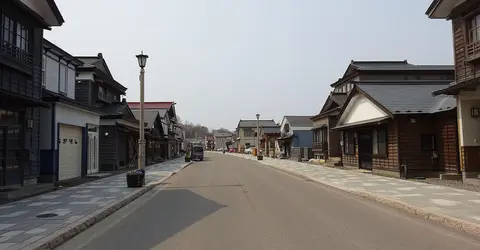The city of Esashi 江差
Historically beautiful and commercial
Esashi is a very beautiful village, steeped in a rich and long history as a trading port on the Nihon Kai coast in southern Hokkaido. It can be visited as much for its summer festival as for its magnificent surrounding maritime landscapes.
On the trade route
Esashi is a village located 70 kilometers from the city of Hakodate, on the Nihon Kai coast (Sea of Japan) in the south-west of Hokkaido. It is listed in the inventory of the most beautiful villages in Japan .
Esashi has long been an important port in the region , along with Hakodate on the Pacific coast and Matsumae on the southernmost tip of the Big North Island, which were among Hokkaido's largest trading ports.
Since the 17th century, the activity was supported by herring fishing and the trade in Japanese cypress wood , the intense production of which went as far as the port of Sakai in Osaka.
Read: Goryokaku Park

Inishie kaido, the shopping street
Wikimedia Commons
The marks of history
The intense commercial activity has left visible traces in the small port city, such as Inishie kaidô , the road to Inishie , where you will find a very beautiful historical and cultural heritage , with mainly wooden buildings from different periods. These beautiful buildings were granaries, houses of prosperous traders, brokers, etc.
In this same district of Inishie, do not miss Ubagami Daijingu, the Ubagami shrine , which is the oldest Shinto temple on the whole island of Hokkaido , founded in 1216. If proof was needed of the rich history of the place, here it is. This sanctuary houses the gods who protect the fishermen . Every year, the remarkable Togyo festival is celebrated there on August 9, 10 and 11 , with the parade of 13 floats that go through the streets of Esashi in a magnificent parade to thank for the good fishing of the past year. This summer festival is preserved as a cultural heritage of Hokkaido, as it is the oldest on the island.
Take the time to stop at the Yokoyama House, which is a very special merchant's house in the city because it has always been inhabited by the same family for 200 years, which means that the eighth generation is currently in charge. You can visit it to immerse yourself in the daily life of the great era of prosperity. You will even be served the specialty of Esashi, Nishin soba, herring soba .

The launch of the Kaiyo Maru
Wikipedia
Eyes turned to the sea
Going towards the sea, in addition to admiring superb sunsets, as only the Nihon Kai coast can offer, you will discover a large boat at the dock, the imposing Kaiyo-maru and its adjoining museum . This ship was built in the Netherlands and then delivered in 1867 to the Shogun Tokugawa, who hoped to make it a centerpiece of his army during the wars against imperial power. She participated in the Battle of Hakodate, but sank in the port of Esashi during a violent storm. Today, a replica of this Kaikyo-maru sits enthroned in the port of Esashi, which can be visited to learn about its history and present the treasures that have been recovered from the wreck.
Your visit to Esashi will end with Kamome Island, which is actually a peninsula because it is connected to land. It is the symbol of the city. 2.6 kilometers to go around in 2 hours by a laid out path. Kamome Island is shaped like a seagull in flight , hence its name kamome which means "seagull" in Japanese. Erosion has sculpted rocks with strange shapes that are quite remarkable, including the Heishi-iwa, sacred rock , with a large tori placed in front of it. It will remind you of Miyajima, but you'll have the added bonus of the sunset here as your backdrop.
See also: What to see during a first trip to Japan?
Address, timetable & access
Address
Timetable
Bus from Hakodate (2h)























